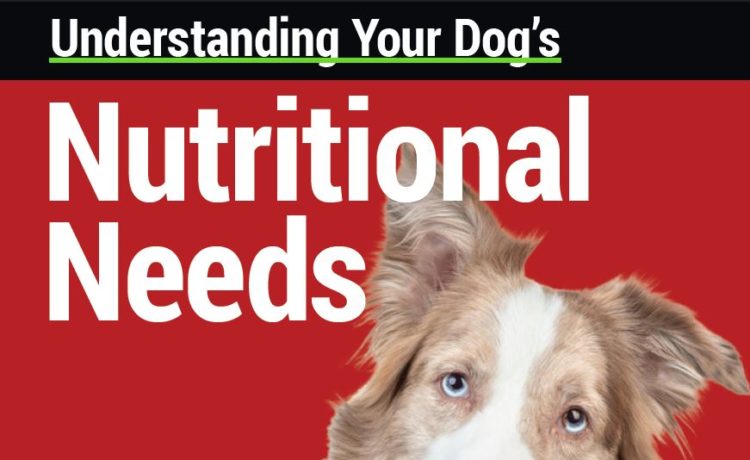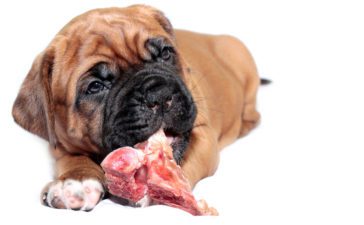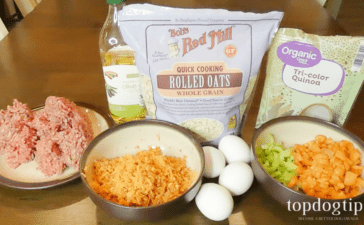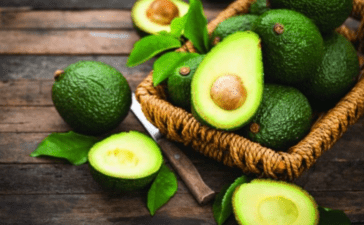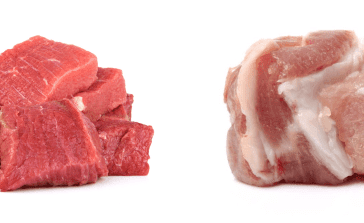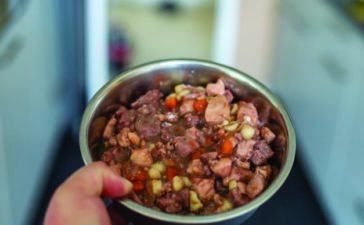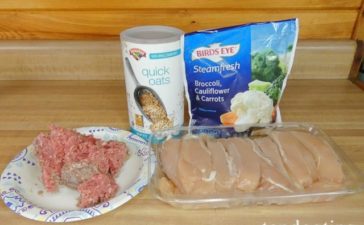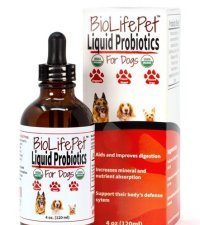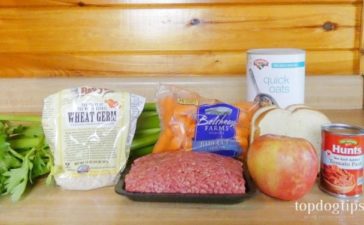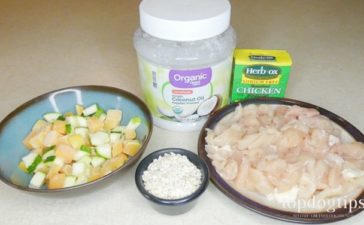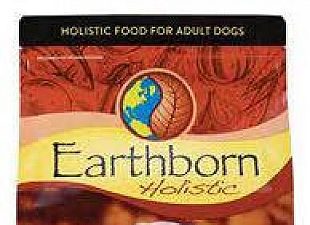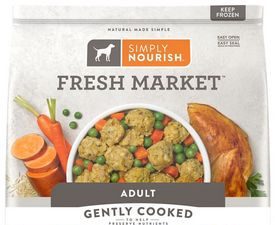Relax, Dogs can thrive off a wide variety of options for Nutritional Needs
For example, let’s start with a look at what the world’s longest-living dogs ate.
Bluey
Australian cattle dog/Australia
lived to almost 30 years of age
Blue ate a fresh [raw] diet of
kangaroo and emu
Bramble
Blue Merle Collie/UK 27 years
Vegan diet of rice, lentils, and organic vegetables
Pusuke
Shiba mix/Japan 26 years
Diet undisclosed but owner believes Pusuke’s longevity was due to supplements
Max
Beagle mix/USA
almost 30 years
Extruded kibble diet
Chilla
Black Lab mix/Australia
32 years
Leftovers are supplemented once a week with canned pet food.
Understanding Your Dogs Nutritional Needs

Basic requirements
Your dog’s food needs to provide
energy
building blocks for tissues
and components necessary for body functions
Energy can come from fats, carbohydrates, or proteins. Proteins can be
broken down for energy or used as building blocks to repair and maintain tissues and become functional proteins such as enzymes, antibodies, etc.
Minerals
Minerals fulfill a variety of functions. For example, they provide building blocks for the growth and maintenance of healthy bones. But minerals are also involved in maintaining fluid balance, pH regulation, nerve transmission, muscle function, blood clotting, immune function, energy metabolism, and more.
Vitamins3
Vitamins can be water- or fat-soluble. They don’t provide energy but are
essential for cell function, growth, and development.
Water-soluble – B vitamins work with enzymes to facilitate:
metabolism
nerve function
digestive function
immune function
skin health
growing new cells
Note: vitamin C belongs under water-soluble vitamins, but a healthy dog’s
body can make its own vitamin C.
Fat-soluble – vitamins A, D, E, and K support:
immune function
vision
healthy skin and mucous membranes
mineral absorption
blood clotting
protection from free radicals
Specific Nutritional Requirements for Dogs
In the USA, nutritional requirements, legal definitions, and labeling requirements
for dog food were established by the Association of American
Feed Control Officials (AAFCO).
The guidelines list essential nutrients and required amounts and
proportions of proteins and amino acids, fats, minerals, and vitamins.
Interestingly, reviewing the table, you will find no mention of carbohydrate
requirements–carbohydrates are not essential nutrients for dogs.
Download E-Book Here
Nutrient requirements are indicated on a dry-matter basis and are per kg of diet, not per kg of animal
body weight. These AAFCO nutrient profiles for dog foods presume an energy density of 3.5 kcal
ME/g dry matter. Rations >4 kcal/g should be corrected for energy density.
Most nutrients list minimum amounts; only a few include maximum. Why?
In life, health is about balance. Both nutrient deficiencies and excesses
lead to trouble. Some nutrients, in excess, can be toxic, such as with
fat-soluble vitamins, especially vitamin A and D.
How did AAFCO come up with these guidelines?
The original Canine and Feline Nutrition Expert Subcommittees convened
in 1990 to establish practical nutrient profiles for dog and cat foods based
on commonly used ingredients. Over time, these guidelines underwent
updates and revisions in cooperation with other agencies. The National
Research Council (NRC) maintains nutritional requirements for dogs
based on research with purified diets and/or highly bioavailable nutrient
sources. These, however, are deemed as not practical to use in commercial
dog foods. Make of it what you may.
Interestingly, as I found from Sean Delaney, DVM, MS, DACVN, a Diplomate
of the American College of Veterinary Nutrition, none of these values
were based on analysis of what natural canine diet in the wild would be.
Wouldn’t that be the most straightforward and most logical approach?
However, dog foods that follow the AAFCO guidelines are the “golden
standard” and provide adequate nutrition.
Logical view on canine nutrition needs
If dogs lived in a Zoo, their diet would try to approximate one of their wild
counterparts.
Many animals at the Zoo receive whole prey in their diets. Reptiles, birds
and smaller mammal species are fed whole prey including mice, rabbits
and fish. African lions, cheetahs, vultures and other carnivores are fed
portions of whole carcasses.5
Why wouldn’t this approach make sense for dogs? The argument is that
domesticated dogs share lives with humans for a long time. Their bodies
adapted to the food they received. For example, dogs evolved to tolerate
much higher levels of carbohydrates.6
That is no surprise–did you look at what percentage of nutrients in
most dog food are carbohydrates? Do you remember that the AAFCO
guidelines list zero requirements for carbs in dog nutrition? It boils down
to what is practical and affordable. Carbohydrates in dog nutrition are a
controversial issue further complicated because most ingredients that
provide carbs also supply protein. And now we can start a debate about
how beneficial plant-source proteins are.
However, dogs have adapted to what humans feed them.
The most dangerous way to feed your dog
To offer the best nutrition to their dogs, many well-meaning dog parents
make a critical mistake. Feeding a dog mostly muscle meat leads to
severe deficiencies. How could that be? Whether you believe that dogs
are carnivores or omnivores, muscle meat provides limited nutrition.
A simple rule to understanding your dog’s nutritional needs
The organ has what the organ needs. In other words, the heart feeds the
heart, the liver feeds the liver, muscle feeds the muscle, and so on. If you
want to feed the whole dog, you need to either:
feed whole pray, bones and organs and everything
feed as many parts as you can and supplement for the missing
nutrients
It is not impossible to do, but it requires education, determination, and a
strong stomach. But if you couldn’t do it right, don’t do it at all and stick
to commercial diets. The selection on today’s market is broad and ought
to satisfy any feeding believes you hold.
What might be more important than the type of food you feed
Regardless of what you feed, there is a way to help your dog live longer
and healthier–feed less.7
The results of a study of 48 Labrador Retrievers that evaluated the effects
of diet restriction might surprise you. Simply feeding less significantly
increased the life span and delayed onset of chronic disease than the
control group of dogs.
And, if you feed less, you can afford higher-quality food too.
How to pick a commercial dog food
Admittedly, making sense of the available variety of dog foods out there
isn’t an easy task either. Pick the best quality food you can afford. Look
back at the various diets of the longest-living dogs. They ate anything
from a vegan diet, leftovers to commercial kibble.
Generally, though not always, the price tag corresponds with the quality.
On the upside, though, the more expensive food is typically more nutritious,
and you can feed much less of it than the cheap alternative.
Learn how to read dog food labels. It is tricky but not impossible to
decipher. Lean toward products that use whole-food ingredients.
By-products and dog nutrition
Should you stay away from foods that use animal byproducts as an
ingredient?
AAFCO definition of by-products states that meat by-products are the
non-rendered, clean parts, other than meat, derived from slaughtered
mammals. It includes, but is not limited to:
lungs
spleen
kidneys
brain
livers
blood
bone
partially de-fatted low
temperature fatty tissue
stomachs and intestines
freed of their contents
It does not include:
hair
horns
teeth and hoofs
How do you feel about that list? Those are all excellent, nutritious ingredients.
However, if they are listed simply as by-products, how would you
know which ones and in what proportions are included?
In other words, there is nothing wrong with animal by-products in dog
food as long as the manufacturer adheres to the guidelines. It is, however,
much better if they care to list them individually, and some do.
The same applies to protein sources listed simply as meat.
Meat
AFFCO defines meat as primarily muscle tissue of the animal but may
include fat, gristle, and other tissues typically accompanying the muscle,
including:
overlying fat and portions of the skin
sinew
nerve and blood vessels which normally accompany the flesh
Muscle tissue includes skeletal muscle as well as:
heart
tongue
esophagus
diaphragm
All of that is nutritious stuff great for your dog. However, if the ingredients
list simple “meat: hat animal or animals does it come from? There is no
way to tell.
Therefore, it is much better if the manufacturer lists the source they used.
Look for specific ingredients and try to avoid foods that simply list “meat”
or “byproducts” if you can.
What doesn’t belong in dog food?
You likely heard the advice to avoid foods that list ingredients that don’t
sound English. That is relatively true, but not everything is bad just
because you don’t know what it means. For example, mixed tocopherols
are compounds present in vitamin E. Dog food manufacturers use them
as natural preservatives.
Before you get worked up over weird-sounding ingredients, learn what
they are.
There are, however, things that you should try and avoid in your dog’s
food, such as:
coloring agents (dogs don’t care about the color of their food)
artificial flavors
artificial preservatives such as BHA, BHT or ethoxyquin
monosodium glutamate (MSG)
Note about semi-moist foods
Semi-moist foods look attractive as they come in patties, chunks, and
other appealing shapes. They look fresh. However, it generally contains
the same ingredients as extruded kibble and goes through the same
extrusion process. Once processed, to keep them moist, the manufacturer
adds agents called “humectants.” such as:
sugar
sodium chloride
sorbate
propylene glycol
However yummy these products might look, I recommend you stay away
from them.
Can dogs eat people food?
Why not? Does people’s food grow on “different trees” than dog food? Yes, dogs can eat people’s food as long as you offer the right kind and the right amount. The reasons you should be thoughtful about what you
share from your pot or plate are:
disturbing nutritional balance
some people’s foods are toxic to dogs
Otherwise, most healthy foods for
you are healthy for your dog, and
you can use them as treats or an
occasional substitute meal if you
run out of dog food. Junk food is
equally bad for you and your dog.
If you want to home-cook for your
dog, make sure you have recipes
that provide complete and balanced
Dog-friendly people-foods
lean meats
organs meats
cooked fish
eggs
most veggies
most fruits
People-foods toxic to dogs:
xylitol
grapes and raisins
onions
chocolate
caffeinated items
macadamia nuts
alcohol and yeast dough
fruit pits and seeds
rotten or moldy foods
Source: Foods You Should Never Feed
Your Dog
Foods that are not toxic but
could harm your dog:
fatty foods, especially pan
drippings
foods high in sugar, salt, or
spices
corncobs
cooked bones
raw fish
How do your dog’s nutritional needs change over time?
It is essential to understand how your dog’s nutritional needs change
through its life stages. For example, can you feed your dog the same
food from puppyhood to old age?
Nutritional needs of puppies
Naturally, puppies’ nutritional
needs are different from adult
dogs–their food needs to support
healthy growth. Therefore, puppy
food needs to be high-calorie and
nutritionally dense. Generally, you
can switch to adult food when the
puppy reaches about 90% of its
adult size.
Special measures apply to largebreed
dogs. A large-breed dog
needs to grow at a relatively slow,
steady rate to develop into healthy
adults and avoid orthopedic disease.
Therefore, diets for large-breed dogs
need to be lower in energy and have
reduced calcium and phosphorus
levels at a strict ratio.
maintenance nutrition
Unless your adult dog is pregnant
or their lifestyle or health circumstances
dictate dietary adjustments,
they can eat most of the
food options that are out there.
Mature adult and senior dog nutrition
Depending on their diet, you may
need to make adjustments as your
dog ages. The criteria to consider
for your older dog include:
maintaining optimal weight
by lowering fat content
adjusting the amount and
type of protein to maintain
muscle mass without taxing
the kidneys
increased levels of anti-oxidants
and anti-inflammatory
nutrients
Summary
Your dog can do well on most foods available. Diet is not the sole factor
in health and longevity. Pick the best food you can afford.
However, should you want to make your dog’s food yourself, make sure
you end up with a complete and balanced diet. Get good recipes and
stick with them.
Note: Variety is healthy and helps to deal with deficiencies, excesses, or
contaminants. However, dogs who ate the same formula for a long time
need time to gradually adjust to any change.

